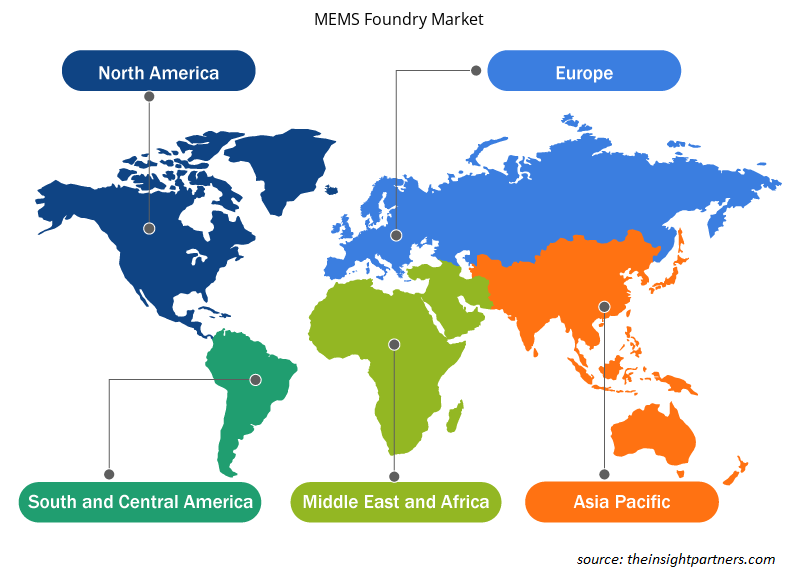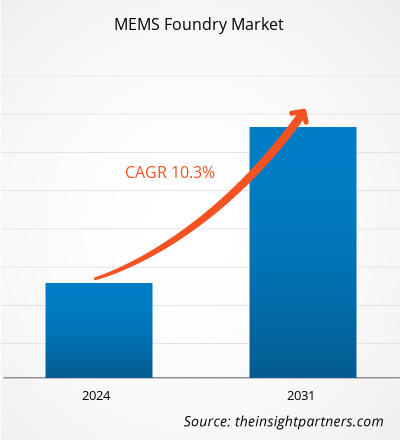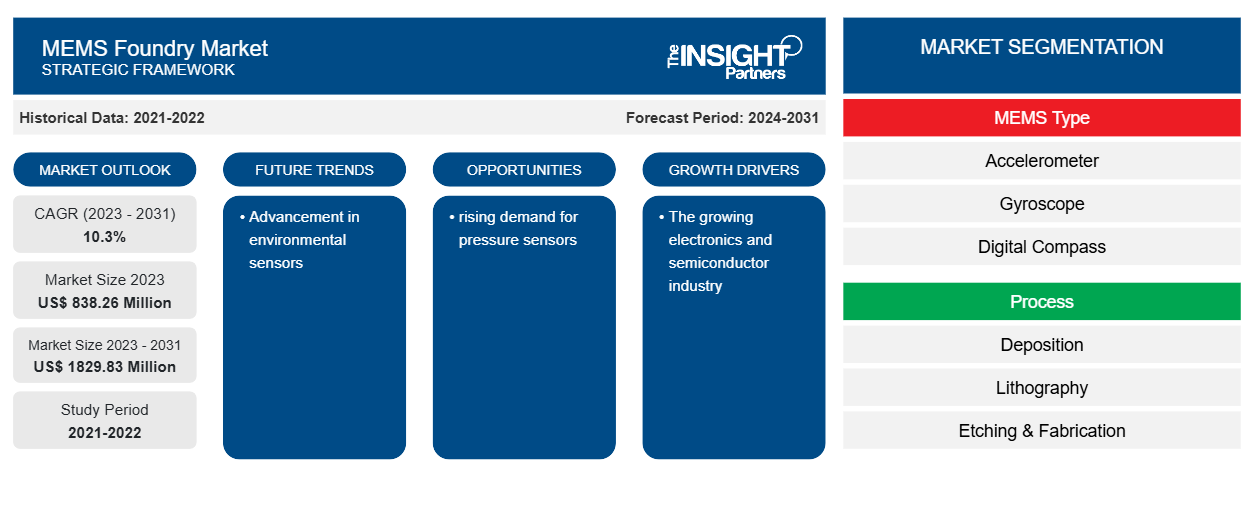Der Markt für MEMS-Gießereien soll von 838,26 Millionen US-Dollar im Jahr 2023 auf 1.829,83 Millionen US-Dollar im Jahr 2031 anwachsen. Der Markt wird zwischen 2023 und 2031 voraussichtlich eine durchschnittliche jährliche Wachstumsrate (CAGR) von 10,3 % verzeichnen. Die wachsende Elektronik- und Halbleiterindustrie und die steigende Nachfrage nach Drucksensoren dürften weiterhin wichtige Trends auf dem Markt bleiben.
MEMS-Gießerei-Marktanalyse
Die steigende Anzahl von Unterhaltungselektronik und tragbaren Geräten treibt das Marktwachstum an. Die wachsende Halbleiterindustrie treibt das Marktwachstum weiter an. Der Anstieg der Anwendung von MEMS-Sensoren im Verteidigungssektor fördert den Markt. Der wachsende Markt für Fahrzeuge, Roboter, Gerätehandhabungsgeräte und andere treibt den Markt weiter an.
MEMS-Gießereimarktübersicht
Eine MEMS-Gießerei ist eine spezialisierte Produktionsstätte, in der MEMS-Designgeräte entworfen und hergestellt werden. Diese Geräte sind kleine integrierte Systeme, die elektrische und mechanische Komponenten kombinieren, die für Sensoren, Aktuatoren, Mikromotoren und andere kleine Komponenten verwendet werden. Sie bieten die Flexibilität, Substratmaterialien wie Galliumarsenid (GaAs), Silizium-auf-Isolator (SOI), Quarz, Glas, Silizium und komplementäre Metalloxid-Halbleiter (CMOS)-Wafer zu verwenden.
Passen Sie diesen Bericht Ihren Anforderungen an
Sie erhalten kostenlos individuelle Anpassungen an jedem Bericht, einschließlich Teilen dieses Berichts oder einer Analyse auf Länderebene, eines Excel-Datenpakets sowie tolle Angebote und Rabatte für Start-ups und Universitäten.
-
Holen Sie sich die wichtigsten Markttrends aus diesem Bericht.Dieses KOSTENLOSE Beispiel umfasst eine Datenanalyse von Markttrends bis hin zu Schätzungen und Prognosen.
Treiber und Chancen auf dem MEMS-Gießereimarkt
Anstieg im Markt für Unterhaltungselektronik
Der wachsende Markt für Unterhaltungselektronik treibt vor allem den MEMS-Gießereimarkt an. Zunehmende Verbreitung verschiedener Arten von Unterhaltungselektronikgeräten wie Tablets, Computern, Smartphones, elektronischen Gadgets, Haushaltsgeräten, Smart Wearables usw. Darüber hinaus wird die Nachfrage nach Halbleiterchips weltweit auch hauptsächlich vom Unterhaltungselektroniksektor getrieben. Die MEMS-Gießerei beschäftigt sich hauptsächlich mit der Herstellung von Mikrokomponenten für Unterhaltungselektronikprodukte, da sie auch hierfür ein großes Auftragsvolumen hat.
Nachfrage nach Drucksensor
Drucksensoren werden in einer Vielzahl von Anwendungen eingesetzt, beispielsweise in der Automobilindustrie, Medizin, im Bauwesen, in der Industrie und in der Luftfahrt. Die Nachfrage nach MEMS-Gießereidiensten für Drucksensoranwendungen wird hauptsächlich durch den Bedarf an der Herstellung von Chips und Halbleiterkomponenten für die Entwicklung von Drucksensoren getrieben. Darüber hinaus gibt es einige wichtige Anwendungen, die die Nachfrage nach MEMS-Gießereien für Drucksensoranwendungen antreiben.
Automobilindustrie: Die Automobilindustrie nutzt Drucksensoren für eine Vielzahl von Anwendungen, beispielsweise für verschiedene Antriebsstränge, darunter MAP, BAP, Partikelfilter, Kraftstofftankverdunstungsantriebe, Abgasantriebe, Motoren und Getriebeölantriebe.
Medizin: Zu den medizinischen Anwendungen von Drucksensoren gehören die Blutüberwachung von Patienten (invasiv und nicht-invasiv), Atmungssysteme, intelligente Inhalationsgeräte und andere Behandlungsgeräte und -systeme, die in Krankenhäusern und medizinischen Notfällen verwendet werden.
Segmentierungsanalyse des MEMS-Gießereimarktberichts
Wichtige Segmente, die zur Ableitung der MEMS-Gießerei-Marktanalyse beigetragen haben, sind der MEMS-Typ, der Prozess, der Gießereityp und der Endbenutzer.
- Basierend auf dem MEMS-Typ ist der MEMS-Gießereimarkt in Beschleunigungsmesser, Gyroskop, Digitalkompass , MEMS-Mikrofon, Drucksensor, Temperatursensor und andere unterteilt. Das Beschleunigungsmessersegment hatte im Jahr 2023 den größten Marktanteil.
- Nach Verfahren ist der Markt in Abscheidung, Lithographie, Ätzen und Fertigung sowie Verpackung unterteilt. Das kommerzielle Segment hielt im Jahr 2023 einen erheblichen Marktanteil.
- Nach Gießereityp ist der Markt in piezoelektrische, elektrostatische, ferroelektrische, elektromagnetische und andere Bereiche unterteilt. Das piezoelektrische Segment hielt im Jahr 2023 einen bedeutenden Marktanteil.
- Nach Anwendung ist der Markt in Unterhaltungselektronik, Automobil, Industrie, Gesundheitswesen und andere unterteilt. Das Segment Unterhaltungselektronik hielt im Jahr 2023 den größten Marktanteil.
MEMS-Gießerei-Marktanteilsanalyse nach geografischer Lage
Der geografische Umfang des MEMS-Gießereimarktberichts ist hauptsächlich in fünf Regionen unterteilt: Nordamerika, Asien-Pazifik, Europa, Naher Osten und Afrika sowie Süd- und Mittelamerika.
Der asiatisch-pazifische Raum wird voraussichtlich das höchste CAGR-Wachstum aufweisen. Die wachsende Elektronik- und Halbleiterindustrie in den APAC-Ländern treibt die Einführung von MEMS-Sensoren voran, was die Expansion des MEMS-Gießereimarktes weiter unterstützt. Darüber hinaus wird erwartet, dass die Massenproduktion elektronischer Geräte wie Wearables, Smartphones und Fernseher in Taiwan und China die Nachfrage nach Sensoren steigern und zum Wachstum des MEMS-Gießereimarktes führen wird.
Regionale Einblicke in den MEMS-Gießereimarkt
Die regionalen Trends und Faktoren, die den MEMS-Gießereimarkt während des Prognosezeitraums beeinflussen, wurden von den Analysten von Insight Partners ausführlich erläutert. In diesem Abschnitt werden auch die Marktsegmente und die Geografie von MEMS-Gießereien in Nordamerika, Europa, im asiatisch-pazifischen Raum, im Nahen Osten und Afrika sowie in Süd- und Mittelamerika erörtert.

- Erhalten Sie regionale Daten zum MEMS-Gießereimarkt
Umfang des MEMS-Gießerei-Marktberichts
| Berichtsattribut | Details |
|---|---|
| Marktgröße im Jahr 2023 | 838,26 Millionen US-Dollar |
| Marktgröße bis 2031 | 1829,83 Millionen US-Dollar |
| Globale CAGR (2023 - 2031) | 10,3 % |
| Historische Daten | 2021-2022 |
| Prognosezeitraum | 2024–2031 |
| Abgedeckte Segmente |
Nach MEMS-Typ
|
| Abgedeckte Regionen und Länder |
Nordamerika
|
| Marktführer und wichtige Unternehmensprofile |
|
Dichte der Marktteilnehmer im MEMS-Gießereisektor: Auswirkungen auf die Geschäftsdynamik verstehen
Der Markt für MEMS-Gießereien wächst rasant. Dies wird durch die steigende Nachfrage der Endnutzer aufgrund von Faktoren wie sich entwickelnden Verbraucherpräferenzen, technologischen Fortschritten und einem größeren Bewusstsein für die Vorteile des Produkts vorangetrieben. Mit der steigenden Nachfrage erweitern Unternehmen ihr Angebot, entwickeln Innovationen, um die Bedürfnisse der Verbraucher zu erfüllen, und nutzen neue Trends, was das Marktwachstum weiter ankurbelt.
Die Marktteilnehmerdichte bezieht sich auf die Verteilung der Firmen oder Unternehmen, die in einem bestimmten Markt oder einer bestimmten Branche tätig sind. Sie gibt an, wie viele Wettbewerber (Marktteilnehmer) in einem bestimmten Marktraum im Verhältnis zu seiner Größe oder seinem gesamten Marktwert präsent sind.
Die wichtigsten auf dem MEMS-Gießereimarkt tätigen Unternehmen sind:
- Ensinger Gruppe
- Teledyne Digital Imaging Inc
- Taiwan Semiconductor Manufacturing Co Ltd
- ROHM CO, LTD
- Silex Microsystems
- STMicroelectronics
Haftungsausschluss : Die oben aufgeführten Unternehmen sind nicht in einer bestimmten Reihenfolge aufgeführt.

- Überblick über die wichtigsten Akteure auf dem MEMS-Gießereimarkt
Neuigkeiten und aktuelle Entwicklungen auf dem MEMS-Gießereimarkt
Der MEMS-Gießereimarkt wird durch die Erhebung qualitativer und quantitativer Daten nach Primär- und Sekundärforschung bewertet, die wichtige Unternehmensveröffentlichungen, Verbandsdaten und Datenbanken umfasst. Nachfolgend sind einige der Entwicklungen auf dem MEMS-Gießereimarkt aufgeführt:
- Sumitomo Precision Products Co., Ltd. (SPP), ein führender Hersteller hochpräziser Industrieprodukte, hat seine Rolle im Fertigungsökosystem für mikroelektromechanische Systeme (MEMS) mit der Einführung von MEMS Infinity ausgebaut, einer 150-mm- und 200-mm-Wafergießerei, die die wachsende Kundennachfrage nach Konzeptdesign und -evaluierung über Prototyping bis hin zur Massenproduktion erfüllt. (Quelle: Sumitomo Precision Products Co., Ltd. (SPP), Pressemitteilung, Januar 2024)
- Silex, die weltweit führende reine Gießerei für MEMS (mikroelektromechanische Systeme), hat die erste 12-Zoll-Waferfabrik für die reine MEMS-Fertigung angekündigt. (Quelle: Silex, Pressemitteilung, April 2024)
Marktbericht zu MEMS-Gießereien – Abdeckung und Ergebnisse
Der Bericht „Marktgröße und Prognose für MEMS-Gießereien (2021–2031)“ bietet eine detaillierte Analyse des Marktes, die die folgenden Bereiche abdeckt:
- MEMS-Gießereimarktgröße und -prognose auf globaler, regionaler und Länderebene für alle wichtigen Marktsegmente, die im Rahmen des Berichts abgedeckt sind
- MEMS-Gießereimarkttrends sowie Marktdynamik wie Treiber, Einschränkungen und wichtige Chancen
- Detaillierte PEST/Porters Five Forces- und SWOT-Analyse
- MEMS-Gießereimarktanalyse mit wichtigen Markttrends, globalen und regionalen Rahmenbedingungen, wichtigen Akteuren, Vorschriften und aktuellen Marktentwicklungen
- Branchenlandschaft und Wettbewerbsanalyse, einschließlich Marktkonzentration, Heatmap-Analyse, prominenten Akteuren und aktuellen Entwicklungen für den MEMS-Gießereimarkt
- Detaillierte Firmenprofile
- Historische Analyse (2 Jahre), Basisjahr, Prognose (7 Jahre) mit CAGR
- PEST- und SWOT-Analyse
- Marktgröße Wert/Volumen – Global, Regional, Land
- Branchen- und Wettbewerbslandschaft
- Excel-Datensatz
Aktuelle Berichte
Erfahrungsberichte
Grund zum Kauf
- Fundierte Entscheidungsfindung
- Marktdynamik verstehen
- Wettbewerbsanalyse
- Kundeneinblicke
- Marktprognosen
- Risikominimierung
- Strategische Planung
- Investitionsbegründung
- Identifizierung neuer Märkte
- Verbesserung von Marketingstrategien
- Steigerung der Betriebseffizienz
- Anpassung an regulatorische Trends























 Kostenlose Probe anfordern für - MEMS-Gießereimarkt
Kostenlose Probe anfordern für - MEMS-Gießereimarkt